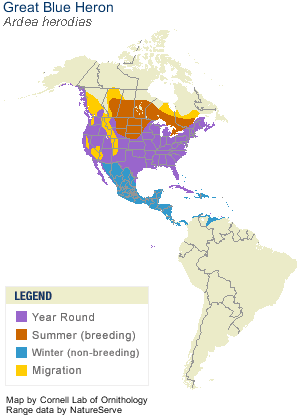 Here's some interesting facts about herons: Great Blue Herons are year round residents in much of this country. They are about 38.2"-53.9" in length. Their wingspan extends from 65.7-79.1" (that's over 6 feet wide!!!). Despite their impressive size, herons only weigh 5-6 lbs. That's due to the fact that, like all birds, their bones are hollow. Heron hunt day and night thanks to rod-type photoreceptors in their eyes improving their night vision. While waiting for its prey, herons will stand for long periods of time as still as a statue and then strike lightening fast to snap up its catch. (All the information gathered here was obtained from the websites linked below.)
Here's some interesting facts about herons: Great Blue Herons are year round residents in much of this country. They are about 38.2"-53.9" in length. Their wingspan extends from 65.7-79.1" (that's over 6 feet wide!!!). Despite their impressive size, herons only weigh 5-6 lbs. That's due to the fact that, like all birds, their bones are hollow. Heron hunt day and night thanks to rod-type photoreceptors in their eyes improving their night vision. While waiting for its prey, herons will stand for long periods of time as still as a statue and then strike lightening fast to snap up its catch. (All the information gathered here was obtained from the websites linked below.)
A heron's chest feathers continually grow and fray. The heron will comb this 'powder down' with a fringed claw on their middle toes and use this down as a washcloth to remove fish slime and other oils from their feathers. Applying this powder to their underparts protect their feathers against slime and swamp oil.
Herons live near fresh or salt water, near lakes or marshes. Although mostly solitary, when its time for breeding they will gather in colonies or heronries and build nests high atop trees in order to protect their young from prey. Once the nest is deemed ready and after a rather complex courtship, mama heron will lay between 2-6 eggs. Incubation lasts around 27-29 days with mom and dad taking turns minding the nest, turning the eggs and caring for the young. The young will stay in the nest for 49-81 days. Heron have 1-2 broods a year.
Building a nest (mostly from twigs and branches) can take 2-3 weeks.
Heron will return to their breeding grounds and reuse their nests adding
to them year after year. A mature nest can be 4 feet wide and 3.5 feet
deep. |
| Count the yellow arrows above - SIX herons in this photo! |
In the picture below, notice the white arrows placed to help you find all the herons just in this small area.
 |
| Count FIVE in the above photo - one in flight in the lower left. |
 | ||||||||||||||||||||||||||||||||||||||||
| I think these are condominiums ;) |
Herons can create up to 500 nests per colony! There weren't that many in this rookery, but it was fascinating nonetheless.
Herons eat fish, reptiles, small birds, small mammals, insects and amphibians. Herons are known to congregate at fish hatcheries which could cause problems for the fish farmers. However studies have shown that herons tend to eat mostly the diseased fish (yuck!) that would have died soon anyway. This happens because sick fish spend more time at the water's surface, making them more vulnerable to hungry herons. Heron swallow their food whole, so they only consume what they can handle. However, heron can be greedy when it comes to their food, so many have died from choking on food that is too large for them to swallow.
Photo below taken locally a year or so ago just as spring was providing some much needed thaw.
Nature sure is remarkable! I hope you enjoyed a glimpse at a heron rookery as much as I did. Take a moment today to enjoy the sights, sounds and smell of Spring and come back soon to Life As I See It. To read more about Great Blue Herons, use the links provided below.



















No comments